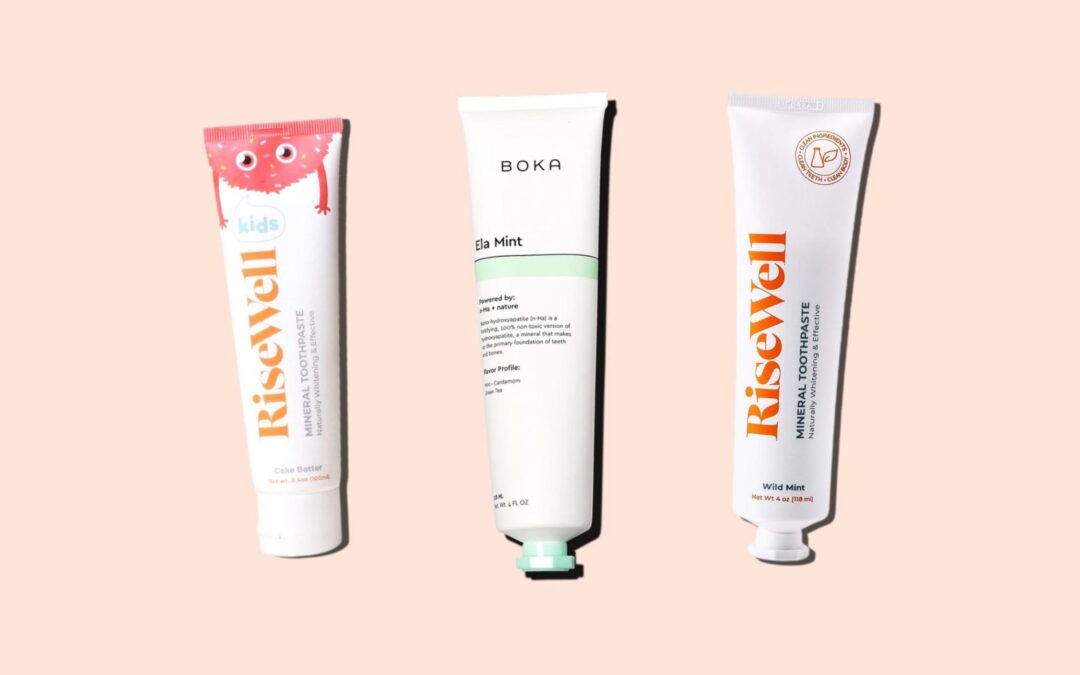Dentists have recommended fluoride toothpaste for stronger cavity-resistant teeth for decades. It is still considered the “gold standard” in dental schools, despite its safety concerns.
But there’s a new ingredient in town proven to be just as effective as fluoride and completely non-toxic.
It’s called hydroxyapatite. Hydroxyapatite toothpaste has replaced fluoride toothpaste as what I recommend to all of my patients. But what is hydroxyapatite toothpaste?
In this blog post, we will learn about hydroxyapatite and take a look at how fluoride compares with it.
How Does Fluoride Toothpaste Work?
Your teeth have an outer covering called enamel that is made up of calcium and phosphate. Your saliva also contains calcium and phosphate that constantly bathe your teeth. These minerals keep your teeth strong.
Bacteria found in cavities can break down food particles and create an acidic environment in your mouth. This acidic environment is harsh and can strip away these beneficial minerals from the surfaces of your teeth. This process is called demineralization.
The fluoride in fluoridated toothpaste works by:
Teaming up with the calcium and phosphate in your saliva and teeth to form a compound called fluorapatite. This compound looks like a crystal lattice (apatite crystal lattice).Covering demineralized enamel with the more acid-resistant fluorapatite. This remineralizes the teeth, restores their strength, and protects it from further damage by acid. How Does Hydroxyapatite Toothpaste Work?
Hydroxyapatite is a form of calcium that makes up 97% of your tooth enamel and nearly 70% of the dentin of your teeth.
The rest of your enamel is actually composed of water, collagen, and other proteins.
Hydroxyapatite is absorbed by the teeth and fills the enamel fissures caused by demineralization.
The most widely studied type of hydroxyapatite is nano-hydroxyapatite. Toothpaste that contains nano-hydroxyapatite has particle sizes between 20-80 nanometers (nm). Because of its small size, it can insert into really small spaces, which leads to better benefits.
Unlike fluoride, hydroxyapatite works by:
Remineralizing enamel from within, reaching the innermost part of a dental cavityBinding to plaque and harmful bacteria in our mouth
When it comes to which toothpaste is more efficient, there is really no difference between hydroxyapatite and fluoride toothpastes.
One study compared 10% hydroxyapatite with 500 ppm F− (amine fluoride), which dentists typically prescribe. The researchers discovered that the 10% hydroxyapatite worked just as well as 500ppm F− for remineralization and lesion depth (LD) reduction.
The conclusion of the study was that hydroxyapatite toothpaste is equal to fluoride toothpaste.
Both fluoride and hydroxyapatite can remineralize tooth structure, but here’s why I prefer to recommend hydroxyapatite over fluoride:
Oral microbiome friendly: Although both have antibacterial properties, fluoride kills decay-causing bacteria and some good bacteria. On the other hand, hydroxyapatite does not kill the bacteria. It prevents harmful bacteria from attaching to the enamel.Fortifies enamel: Hydroxyapatite can increase the microhardness of enamel. The coating of hydroxyapatite reinforces the teeth better than the fluorapatite coating.Non-toxic: Hydroxyapatite is biomimetic. There are no side effects with hydroxyapatite—in fact, it’s safe enough to swallow the entire tube of toothpaste! With fluoride, on the other hand, there’s a poison control label on the tube, and overexposure causes dental and skeletal fluorosis.Kid-friendly: At an early age, children don’t have full control over swallowing and can ingest large amounts of toothpaste. When this happens, the fluoride in toothpaste can get absorbed into the bloodstream and cause dental fluorosis (a change in the appearance of tooth enamel). Toothpaste that contains hydroxyapatite reduces the risk of fluorosis.Whitens: Hydroxyapatite toothpaste has been shown to lighten the shade of the teeth without the help of any additional abrasives or whitening agents.
Fluorapatite is less soluble than hydroxyapatite. This means that in acidic conditions, fluorapatite is stronger and more resistant to demineralization.
However, this does not mean that fluorapatite toothpaste is better than hydroxyapatite toothpaste. In fact, studies show that hydroxyapatite toothpaste is just as good as fluorapatite toothpaste, with an added benefit — it helps with dental hypersensitivity.
To me, this is a no-brainer. If you have a better alternative to fluoride toothpaste and it’s non-toxic, why wouldn’t you?
To most dentists, this is a no-brainer as well—however, fluoride is still taught as the “gold standard” in dental schools, and there are still some dentists out there who might be leery of hydroxyapatite. If this is your dentist, send them the research!
I recommend everyone talk to their dentist about switching to a hydroxyapatite toothpaste, especially the following categories of people:
Pregnant womenPeople who live in areas with fluoridated water supplyBabies and children, especially if they are below the age of 6.People with sensitive teeth, as hydroxyapatite treats the root cause of sensitivity.
The biggest advantage of using toothpaste with hydroxyapatite is that it remineralizes your teeth without any side effects, unlike fluoride that is toxic in large quantities.
There are two brands of hydroxyapatite toothpaste brands I recommend to readers. I encourage you to check them out and see which one is right for you.
Boka Ela Mint Toothpaste
RiseWell Mineral Toothpaste
RiseWell Kids’ Mineral Toothpaste (birthday cake flavor)
Hydroxyapatite is naturally present within our body and constitutes most of our enamel.
Both fluoride and hydroxyapatite are scientifically proven to reverse dental decay—why not choose the less toxic one?
